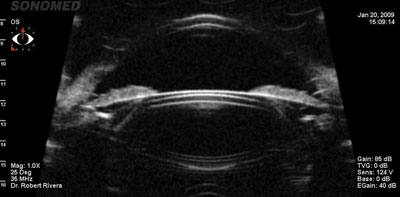High-frequency ultrasound biomicroscopy optimizes lens sizing, vault
Precise measurement of the sulcus-to-sulcus distance helps surgeons choose an optimal lens size and prevent postoperative complications, clinician says.
 Paul J. Dougherty |
High-frequency ultrasound biomicroscopy optimized posterior chamber phakic IOL sizing and minimized complications resulting from inadequate or excessive vault, a study found.
Sulcus-to-sulcus measurement proved more precise than white-to-white measurement in ensuring proper lens sizing and vault, the study authors said.
Ultrasound biomicroscopy (UBM) enables direct measurement of internal structures, increasing the accuracy of posterior chamber phakic IOL sizing, the authors said.
“Most importantly, it’s going to decrease the rate of complications. Your rate of cataract formation is going to be greatly diminished and your rate of needing to exchange an overvaulted lens is going to be greatly diminished,” Paul J. Dougherty, MD, the corresponding author, said in an interview with Ocular Surgery News.
Sulcus-to-sulcus measurements were taken with the VuMax 2 high-frequency UBM system (Sonomed). Patients were implanted with the Visian Implantable Collamer Lens (ICL, STAAR Surgical).
The U.S. Food and Drug Administration sizing nomogram for the Visian ICL is based on white-to-white measurement and has resulted in poor sizing and complications in some cases, Dr. Dougherty said.
“I had four cases of angle closure from oversized lenses using the FDA nomogram,” Dr. Dougherty said. “It made every ICL case a crapshoot for me in terms of sizing. When we got the UBM, all of the sudden I could visualize the sulcus-to-sulcus and could actually measure the area that I was putting the lens implant in. So, I could get a more accurate lens size.”
The study was published in the Journal of Cataract and Refractive Surgery.
Nomogram development
A retrospective analysis with 73 eyes of 48 patients was conducted to develop a UBM nomogram to determine sizing recommendations. The nomogram was based on a comparison of preoperative sulcus-to-sulcus measurements to postoperative vault.
“We used both that information as well as our clinical judgment from a spreadsheet to come up with our own regression equation that took into account primarily sulcus-to-sulcus length in determining which lens size to use,” Dr. Dougherty said. “Once we had the regression formula developed with the retrospective study, we tested it prospectively to make sure it actually worked.”
The prospective study included 73 eyes of 73 patients. One eye was excluded from the study because of a sizing error. The studies involved separate patient populations.
Sizing recommendations based on the nomogram were compared with the FDA nomogram and the PreVize optimized white-to-white method (STAAR/Moran Research and Consulting).
UBM measurements were taken at 1 month and 3 months postoperatively.
Patients and measurements
Study results showed a mean postoperative vault of 340 µm (range: 90 µm to 952 µm). No cases had inadequate or excessive vault as a result of the UBM nomogram. No eyes had vault of less than 90 µm or more than 1,000 µm.
“In my opinion, ideal vault is between 200 µm and 800 µm. Acceptable vault is between 90 µm and 1,000 µm,” Dr. Dougherty said.
 A sizing nomogram based on ultrasound biomicrocopy measurements of sulcus-to-sulcus distance resulted in adequate vault of the Visian Implantable Collamer Lens (ICL, STAAR Surgical) in 100% of cases. Vault of 200 µm to 800 µm is considered ideal. Image: Dougherty PJ |
Vault ranged from more than 100 µm to 500 µm in 55 eyes (76.7%) and from more than 100 µm to 700 µm in 67 eyes (93.1%).
Sizing methods based on white-to-white measurements would have yielded different posterior chamber phakic IOL sizes in 36% to 69% of cases when compared with the sulcus-to-sulcus method, the authors said.
“The most significant finding is that by switching from either the FDA or the Previze nomogram, white-to-white sizing of the ICL, with our nomogram with UBM we found that we had adequate vault in 100% of cases,” Dr. Dougherty said.
Improper vaulting typically does not affect visual quality other than hyperopia resulting from an overvaulted lens, he said.
“The issue is angle closure,” Dr. Dougherty said. “It is a nightmare for the patient and the surgeon.”
Angle closure resulting from overvault is far more problematic than cataract that may result from undervault, Dr. Dougherty said. – by Matt Hasson
Reference:
- Dougherty PJ, Rivera RP, Schneider D, Lane SS, Brown D, Vukich J. Improving accuracy of phakic intraocular lens sizing using high-frequency ultrasound biomicroscopy. J Cataract Refract Surg. 2011;37(1):13-18.
- Paul J. Dougherty, MD, can be reached at 321 N. Larchmont Blvd., Suite 1021, Los Angeles, CA 90004; 805-987-5300; fax: 805-987-5330; e-mail: flapzap@gmail.com.
- Disclosure: Dr. Dougherty owns stock in and receives travel support from STAAR Surgical.

![]()
Sizing of the phakic IOL is critical in determining the position of the lens implant. Traditionally, sizing was based on the white-to-white measurements, which were obtained by a variety of devices. Correlation between white-to-white and the diameter of the internal sulcus-to-sulcus is not accurate.
For example, an ICL that is too long will have excessive vault; an ICL that is too small will come in direct contact with the crystalline lens, causing cataract formation. Ideally, the lens should have a vault of approximately 500 µm.
Measurement of the sulcus-to-sulcus distance utilizing ultrasound biomicroscopy provided a methodology that allowed the development of a new nomogram, affording accurate predictability of the postoperative vault.
– David C. Brown, MD, FACS
Medical
Director and Founder Eye Centers of Florida
Disclosure: Dr. Brown has no
relevant financial disclosures.
